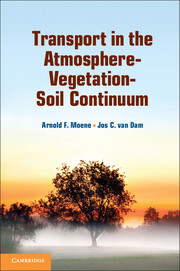Book contents
- Frontmatter
- Contents
- Preface
- 1 The Atmosphere-Vegetation-Soil System
- 2 Available Energy: Net Radiation and Soil Heat Flux
- 3 Turbulent Transport in the Atmospheric Surface Layer
- 4 Soil Water Flow
- 5 Solute Transport in Soil
- 6 Vegetation: Transport Processes Inside and Outside of Plants
- 7 Combination Methods for Turbulent Fluxes
- 8 Integrated Applications
- 9 Integrated Models in Hydrology and Meteorology
- Appendix A Radiation
- Appendix B Thermodynamics and Water Vapour
- Appendix C Dimensional Analysis
- Appendix D Microscopic Root Water Uptake
- Appendix E Crop Factors for Use with Makkink Reference Evapotranspiration
- Answers
- List of Main Symbols
- References
- Index
5 - Solute Transport in Soil
Published online by Cambridge University Press: 05 June 2014
- Frontmatter
- Contents
- Preface
- 1 The Atmosphere-Vegetation-Soil System
- 2 Available Energy: Net Radiation and Soil Heat Flux
- 3 Turbulent Transport in the Atmospheric Surface Layer
- 4 Soil Water Flow
- 5 Solute Transport in Soil
- 6 Vegetation: Transport Processes Inside and Outside of Plants
- 7 Combination Methods for Turbulent Fluxes
- 8 Integrated Applications
- 9 Integrated Models in Hydrology and Meteorology
- Appendix A Radiation
- Appendix B Thermodynamics and Water Vapour
- Appendix C Dimensional Analysis
- Appendix D Microscopic Root Water Uptake
- Appendix E Crop Factors for Use with Makkink Reference Evapotranspiration
- Answers
- List of Main Symbols
- References
- Index
Summary
Introduction
At the soil surface, nutrients, pesticides and salts dissolved in water infiltrate the soil. The residence time of these solutes in the vadose zone may have a large effect on soil and groundwater pollution:
Organic compounds are mainly decomposed in the unsaturated zone, where the main biological activity is concentrated.
Many plants have no active roots below the groundwater level and therefore extract water and nutrients only from the soil in the unsaturated zone.
Whereas in the unsaturated zone the transport of solutes is predominantly vertical, in the saturated zone solutes may disperse in any direction, threatening groundwater extractions and surface water systems.
Therefore, to manage soil and water related environmental problems effectively, proper quantification of the transport processes in the unsaturated zone is important (Beltman et al., 1995). For a number of reasons in delta areas relatively much attention is paid to solute transport in soils. In delta areas like the Netherlands the population density is high, the chemical industry is intensive, the agrochemical input in the agriculture is huge, the sedimented soils are very permeable, the groundwater levels are shallow and the groundwater recharge fluxes are large due to the humid climate.
- Type
- Chapter
- Information
- Transport in the Atmosphere-Vegetation-Soil Continuum , pp. 177 - 199Publisher: Cambridge University PressPrint publication year: 2014



